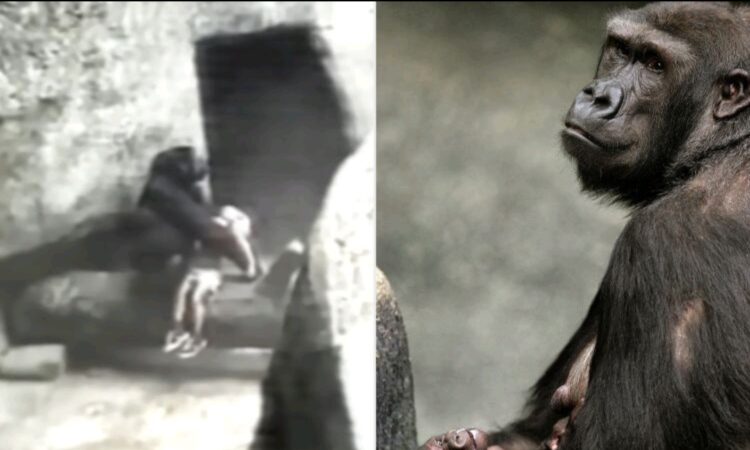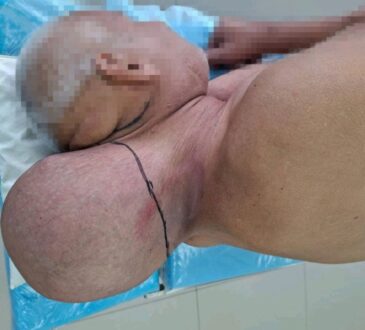Little Boy, 3, Unconscious After Falling 24 Feet into Zoo Enclosure. Seconds Later, The Unexpected Took Place

Among the gorillas was an 8-year-old female named Binti Jua. She weighed around 160 pounds and had a 17-month-old baby gorilla clinging to her back. What she did next took everyone by surprise and left an unforgettable mark on those who witnessed it. Instead of showing aggression or fear, Binti calmly walked over to the unconscious boy. She gently picked him up by his waist, cradled him in her strong but careful arms, and carried him across the enclosure to a door where zookeepers were waiting. Once she reached them, she gently placed the child down and then walked away, leaving him in safe hands.
It was a moment of compassion and intelligence that people around the world found incredibly moving. Many believed that Binti’s maternal instincts kicked in, as she was a mother herself. She not only protected the child from harm, but also seemed to shield him from the other gorillas by turning her body away from them while she held him. Some experts also suggested that her gentle behavior might have been influenced by her background. Binti had been born in captivity and raised by humans, so the sight of a small, helpless human child may have seemed familiar and triggered a sense of empathy.
The child, who was never named publicly, was taken to a hospital. Despite the terrifying fall and the frightening situation, he only suffered a broken hand and some cuts to his face. He stayed in the hospital for four days and made a full recovery.
Binti’s actions quickly became a global story. People everywhere praised her for her kindness and instinct to protect. The incident was covered in newspapers, on television, and discussed in classrooms and families. She received an overwhelming outpouring of love and admiration. People sent her letters, cards, and gifts. An Illinois grocer donated 25 pounds of bananas to her as a thank-you. Some people even offered money to adopt her or support her care.
In the years that followed, Binti became even more popular at the zoo. Visitors came not just to see a gorilla, but to see the gorilla who had saved a little boy. Her story was remembered again in 2016, during a tragic event at the Cincinnati Zoo, where another child fell into a gorilla enclosure. That time, the gorilla involved, Harambe, was a large male and was ultimately shot and killed by zoo officials after he was seen dragging the child. The comparison between the two events brought even more attention to what Binti had done, and how different outcomes can depend on many factors—including the behavior of the animal, the layout of the enclosure, and how the situation is handled.
Now, nearly three decades later, Binti Jua is still alive. She continues to live at the Brookfield Zoo, where she has been since she arrived in 1991 on a breeding loan from the San Francisco Zoo. In March of this year, she turned 37, which is quite an achievement for a Western Lowland Gorilla. In the wild, gorillas of her kind usually live around 35 years, but in zoos where they receive medical care, protection, and regular food, they often live longer.
Western Lowland Gorillas like Binti are critically endangered. Over the past 20 to 25 years, their population has fallen by more than 60 percent. This is mostly because of illegal hunting, habitat loss, and diseases. Despite being strong and intelligent animals, they are vulnerable in the wild, and efforts to protect them are more important than ever.
Binti Jua’s story is more than just an amazing zoo event. It has become a symbol of hope, compassion, and the deep emotional and intelligent lives that animals can have. What she did that day in 1996 didn’t just save a child’s life—it changed how many people view gorillas and helped inspire a greater respect and empathy for animals in general. Her actions reminded the world that kindness and care can come from the most unexpected places—even from a gorilla with her own baby on her back, doing what came naturally: protecting the vulnerable.
In the summer of 1996, something truly extraordinary happened at the Brookfield Zoo near Chicago. A 3-year-old boy was visiting the zoo with his family when he slipped through a barrier and fell 24 feet into the gorilla enclosure. The fall knocked him unconscious, and he lay motionless on the ground surrounded by a group of large gorillas. Visitors watching from above gasped in horror, expecting the worst. The zoo staff quickly tried to contain the situation, using hoses to keep the other gorillas away from the child.
Among the gorillas was an 8-year-old female named Binti Jua. She weighed around 160 pounds and had a 17-month-old baby gorilla clinging to her back. What she did next took everyone by surprise and left an unforgettable mark on those who witnessed it. Instead of showing aggression or fear, Binti calmly walked over to the unconscious boy. She gently picked him up by his waist, cradled him in her strong but careful arms, and carried him across the enclosure to a door where zookeepers were waiting. Once she reached them, she gently placed the child down and then walked away, leaving him in safe hands.
It was a moment of compassion and intelligence that people around the world found incredibly moving. Many believed that Binti’s maternal instincts kicked in, as she was a mother herself. She not only protected the child from harm, but also seemed to shield him from the other gorillas by turning her body away from them while she held him. Some experts also suggested that her gentle behavior might have been influenced by her background. Binti had been born in captivity and raised by humans, so the sight of a small, helpless human child may have seemed familiar and triggered a sense of empathy.
The child, who was never named publicly, was taken to a hospital. Despite the terrifying fall and the frightening situation, he only suffered a broken hand and some cuts to his face. He stayed in the hospital for four days and made a full recovery.
Binti’s actions quickly became a global story. People everywhere praised her for her kindness and instinct to protect. The incident was covered in newspapers, on television, and discussed in classrooms and families. She received an overwhelming outpouring of love and admiration. People sent her letters, cards, and gifts. An Illinois grocer donated 25 pounds of bananas to her as a thank-you. Some people even offered money to adopt her or support her care.
In the years that followed, Binti became even more popular at the zoo. Visitors came not just to see a gorilla, but to see the gorilla who had saved a little boy. Her story was remembered again in 2016, during a tragic event at the Cincinnati Zoo, where another child fell into a gorilla enclosure. That time, the gorilla involved, Harambe, was a large male and was ultimately shot and killed by zoo officials after he was seen dragging the child. The comparison between the two events brought even more attention to what Binti had done, and how different outcomes can depend on many factors—including the behavior of the animal, the layout of the enclosure, and how the situation is handled.
Now, nearly three decades later, Binti Jua is still alive. She continues to live at the Brookfield Zoo, where she has been since she arrived in 1991 on a breeding loan from the San Francisco Zoo. In March of this year, she turned 37, which is quite an achievement for a Western Lowland Gorilla. In the wild, gorillas of her kind usually live around 35 years, but in zoos where they receive medical care, protection, and regular food, they often live longer.
Western Lowland Gorillas like Binti are critically endangered. Over the past 20 to 25 years, their population has fallen by more than 60 percent. This is mostly because of illegal hunting, habitat loss, and diseases. Despite being strong and intelligent animals, they are vulnerable in the wild, and efforts to protect them are more important than ever.
Binti Jua’s story is more than just an amazing zoo event. It has become a symbol of hope, compassion, and the deep emotional and intelligent lives that animals can have. What she did that day in 1996 didn’t just save a child’s life—it changed how many people view gorillas and helped inspire a greater respect and empathy for animals in general. Her actions reminded the world that kindness and care can come from the most unexpected places—even from a gorilla with her own baby on her back, doing what came naturally: protecting the vulnerable.




